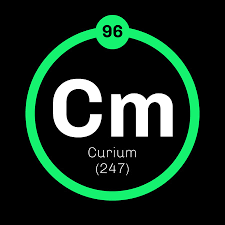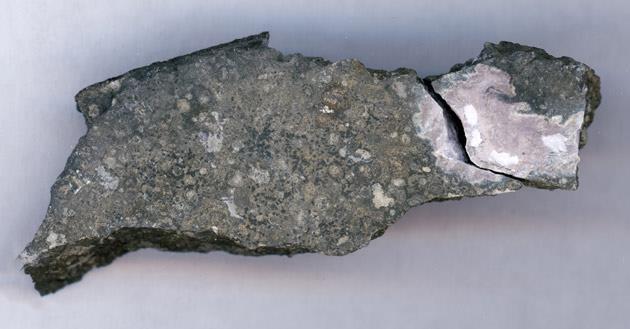Identity.
Born in the fiery hearts of nuclear reactors, Curium (Cm) is a
synthetic element that never graced Earth naturally. Named after the
pioneering Curies, this silvery heavyweight boasts impressive density
and a melting point hotter than most flames. But its defining trait is
its radioactivity, making it unsuitable for everyday life. However,
this "glow" finds use in powering spacecraft and targeted cancer
treatment. Handle with care, as Curium's radioactive punch packs a
serious health risk. Though not pocket-friendly, this rare element
continues to shine bright in scientific exploration, holding potential
for clean energy and fueling our cosmic journeys.
Atomic Structure:
The nucleus consists of 96 protons (red) and 152 neutrons (blue). 96
electrons (green) bind to the nucleus, successively occupying
available electron shells (rings). Curium, named after the Curies and
first synthesised in 1944, is an actinide and transuranic element in
period 7, and the f-block of the periodic table.
History.
In 1944, amidst the throes of World War II, a scientific feat unfolded
at the University of California, Berkeley. Glenn Seaborg, Ralph James,
and Albert Ghiorso, armed with a cyclotron, crafted history's first
curium atoms. Bombarding plutonium with alpha particles, they birthed
element number 96, later named in honor of the Curies, pioneers of
radioactivity research.
But the curium saga wasn't a solo show. The fledgling element had
an enigmatic twin, initially dubbed "delirium" due to their
intertwined nature. It wasn't until 1947 that Louis Werner and
Isadore Perlman, at the University of Chicago, successfully
isolated pure curium hydroxide, solidifying its existence.
News of curium, however, remained classified until after the war.
In a rather unusual debut, Seaborg unveiled it on a children's
radio show, marking a public shift towards transparency in
scientific discovery. Since then, research on curium has unraveled
its unique properties, paving the way for specialized applications
in medicine, space exploration, and even potential future energy
sources. Though born in the lab, curium's story continues to
unfold, revealing its intriguing potential in the wider scientific
landscape.
Usage.
Though rare and radioactive, curium finds light beyond nuclear waste.
It fuels deep-space probes like Cassini, unravels Martian secrets with
the APXS instrument, precisely targets cancer cells in rare therapies,
and holds promise for cleaner nuclear energy in the future. This
lab-born element shines brightly in powering space exploration,
fighting disease, and potentially illuminating a sustainable energy
path.
-
Powering Space Adventures: Curium's radioactivity
generates heat, making it a fuel source for Radioisotope
Thermoelectric Generators (RTGs). These robust power sources
sustain instruments on spacecraft, rovers, and even pacemakers,
where reliable solar energy isn't always available. Missions like
Cassini's journey to Saturn and Voyager 1's interstellar trek owe
their longevity to this remarkable element
-
Unveiling Space Secrets: Curium's alpha particles serve as
a probe in alpha-particle X-ray spectrometry (APXS). This
technique analyzes the elemental composition of rocks and minerals
on planets and asteroids, allowing scientists to unravel clues
about their formation and history. The Alpha Proton X-ray
Spectrometer (APXS) on NASA's Curiosity rover on Mars utilizes
curium to unlock the Red Planet's secrets.
-
Combating Cancer: Despite its dangers, curium can be a
targeted weapon against cancer. Its specific type of radiation
emits short-range bursts that damage tumor cells with minimal harm
to surrounding healthy tissue. Curium-242 is used in Curium-242
brachytherapy, a specialized radiation therapy for certain types
of eye tumors.
-
Fueling the Future: Though still in its early stages,
research is exploring curium's potential as a fuel in novel
nuclear reactors. Some designs propose using curium to burn
transuranic waste, reducing long-term nuclear waste hazards while
generating clean energy. While challenges remain, this potential
application could revolutionize nuclear power.
Some of the benefits of using Curium are:
-
Curium's radioactive decay generates heat, perfect for
Radioisotope Thermal Generators (RTGs). These robust power sources
illuminate deep-space missions like Cassini's Saturn sojourn and
Voyager 1's interstellar voyage, where sunlight is unreliable.
-
Its alpha particles act as a probe in alpha-particle X-ray
spectrometry (APXS). This technique analyzes elements on planets
and asteroids, revealing their composition and history. The APXS
on the Mars Curiosity rover utilizes curium to unlock the Red
Planet's secrets.
-
Despite its radioactive nature, curium can be a precise weapon
against cancer. Its specific radiation offers short-range bursts
that damage tumor cells while minimizing harm to healthy tissue.
Curium-242 brachytherapy utilizes this property to treat specific
eye tumors.
-
Initial research explores curium's potential as fuel in novel
nuclear reactors. Some designs propose using it to "burn"
transuranic waste, reducing long-term nuclear waste hazards while
generating clean energy. While challenges remain, this future
application could revolutionize nuclear power.
Sources.
Curium, forged in nuclear reactors, doesn't exist naturally.
Primarily, it's a byproduct of neutron bombardment within reactors,
often found in spent nuclear fuel (about 20 grams per ton!).
Additionally, it arises from detonation of nuclear weapons, though
production through this means thankfully ceased in the 1980s. While
rare and challenging to handle, curium's unique glow continues to
illuminate advancements in space exploration, medicine, and even
potential future energy sources.
Properties.
Radioactive Radiance: All curium isotopes are radioactive,
emitting alpha particles as they decay. While this makes it dangerous,
it opens doors in applications like powering spacecraft and targeted
cancer treatment.
Metallic Might: Curium is a hard, dense metal with a
silvery-white appearance. Its density surpasses most other metals, and
its melting point reaches scorching temperatures exceeding 3,500 °C.
Magnetic Marvel: This element exhibits intriguing magnetic
properties. It's paramagnetic at room temperature but becomes
antiferromagnetic upon cooling, showcasing complex magnetic behavior
across its various compounds.


